Reducing Hypertension, Term Paper Example
Reducing Hypertension in the Geriatric Population with Diet and Stress Management
Introduction and Rationale
Hypertension, or high blood pressure, affects many people in the United States. It can create specific problems for the geriatric population. Hypertension contributes to health conditions such as heart disease (Schneider et al., 2001, p. 83), diabetes, cerebrovascular incidents, and has even been related to Alzheimer’s disease and dementia. Proper management of hypertension in the elderly can prevent and treat associated pathologies. In 2012, the World Health Organization reported that hypertension causes 51% of deaths related to stroke and 45% of deaths related to coronary heart disease. The American Heart Association (2012) reported that nearly one third of Americans have hypertension. In Americans over age 65, hypertension occurs in 58% of women and 53% of men (Roger, Lloyd-Jones, Benjamin, Berry, Borden, Bravata…, & Turner, M., 2012).
Regulating blood pressure is necessary to maintain optimal health. While medications can effectively reduce blood pressure, they can often cause unwanted side effects such as dizziness, headaches, depression, dry mouth, and sexual dysfunction. Natural options for managing hypertension do exist; the challenge is increasing awareness and availability to senior citizens. Two methods which can help to regulate blood pressure are dietary modification and stress management techniques. Both of these methods are inexpensive and can easily be incorporated into any treatment plan. A healthy diet contributes to weight loss, reduced cholesterol levels, and more efficient metabolism. Learning to manage stress not only increases the quality of life, but slows the heart rate and reduces over-stimulation of the sympathetic nervous system, or the “fight or flight” response to stress.
Dietary modification can help to reduce blood pressure and while there are many effective programs, the Dietary Approaches to Stop Hypertension (DASH) has been shown to reduce blood pressure and control risk factors. Decreasing overall stress levels can help to manage hypertension; high levels of stress can create acute spikes in blood pressure and contribute to chronic hypertension. Meditation practices, specifically with the use of mantras, can help to better manage stress and handle difficult situations typically faced by senior citizens. The purpose of this workshop is to not only create awareness of the relationship of hypertension to various diseases, but also to educate senior citizens about natural strategies that they can use to manage blood pressure. The topic of the workshop is hypertension in the geriatric population and how certain modifications in diet and stress levels can help to better manage it. The workshop will focus on how the DASH diet and the use of mantra meditation can help to effectively manage blood pressure.
Literature Review
Hypertension is a condition where the force of the blood pumping through the arteries is dangerously elevated. It is diagnosed with at least two clinical readings with systolic pressure of 140 mmHg and diastolic reading of 90 mmHg. High blood pressure taxes the heart, causing it to work harder to circulate blood throughout the body. Impaired circulation negatively impacts all organ systems of the body and often contributes to blindness and kidney damage. Senior citizens may be more susceptible to hypertension due to increased arterial stiffness and calcification of large arteries (Franklin, Jacobs, Wong, L’Italien, & Lapuerta, 2001). Hypertension contributes to many ailments such as heart disease, stroke, and diabetes. It may be related to conditions specifically associated with the geriatric population, such as Alzheimer’s disease and dementia.
Hypertension is often treated with medications designed to lower blood pressure. Though these medications may be effective in reducing blood pressure, they can often cause severe side effects such as dry mouth, depression, muscle aches, fatigue, and sexual dysfunction. Anti-hypertensive medications may also negatively interact with other prescription drugs. According to Schneider et al. (2001), even with the use of anti-hypertensive drugs, the incidence of cardiovascular disease and mortality continue to be higher among patients with hypertension (p. 86). However, natural options are available and can benefit all people, including the geriatric population.
Improving the diet can help to reduce and manage hypertension in senior citizens. By regulating cholesterol and reducing weight, a healthy diet helps to increase vascular health and optimize blood circulation. Though there are many healthy diets, the DASH diet has been clinically shown to reduce blood pressure. The DASH diet helps to reduce blood pressure with its “increased intake of vegetables, fruits, and low-fat dairy foods and reduced intake of fats” (Rankins, Sampson, Brown, & Jenkins-Salley, 2005, p. 259). It also includes whole grains and lean proteins such as fish, poultry, and nuts. Consumption of red meats, sweets and sugars are reduced. Fiber is emphasized along with importance of nutrients such as potassium, magnesium, and calcium. Sodium is regulated to levels of 1500-2300 mg/day. By balancing sodium with potassium, magnesium, and calcium, metabolism is better regulated at a cellular level. Adherence to the DASH diet reduced both systolic and diastolic blood pressure in the study population of patients with hypertension (p. 259).
According to Champagne (2006), 459 participants were randomized into the DASH trial; the majority were overweight and with elevated blood pressure (p. 54). The DASH diet succeeded in lowering both systolic blood pressure and diastolic blood pressure significantly, while a generic diet based on the consumption of fruits and vegetables only lowered systolic blood pressure significantly (p. 54). Other benefits founded by Champagne (2006) included “lowered total cholesterol by 13.7 mg/dL, low-density lipoprotein (LDL) by 10.7 mg/dL, and high-density lipoprotein (HDL) by 3.7 mg/dL relative to the control diet (P < 0.001 for each of the lipid values)” (p. 54). The generic diet of fruits and vegetables did not produce any change of significant status in “total cholesterol, LDL cholesterol, or HDL cholesterol” (p. 55). The results show that the DASH diet specifically is able to improve overall health.
Harnden, Frayn, and Hodson (2009) tested the efficacy of the DASH diet in a UK context, though their study used healthy volunteers (p. 4). The study emphasized maintaining a healthy weight whiling increasing the consumption of fruits, vegetables, and low-fat dairy, while restricting the intake of salt (p. 4). The participants in the study were asked to maintain their current exercise programs throughout the course of the study (p. 6). This clinical trial produced significant losses of weight, notably due to reductions in both saturated and monounsaturated fatty acids (p. 6). Other salutary results included increases in the consumption of protein, carbohydrates, and potassium, and a decrease in consumption of sodium (p. 6). Reductions in systolic blood pressure and diastolic blood pressure were also observed (p. 7).
Svetkey et al. (2004) evaluated the impact of DASH in the context of the efficacy of behavioral intervention. In their study, these authors compared a group of participants that received only a behavioral intervention, one which “implemented traditional lifestyle recommendations”, with a group that received this behavioral intervention plus the DASH diet (p. 22). The control group was given advice only, and had no other kind of intervention (p. 22).
Svetkey et al. (2004) found that all three groups experienced significant and positive changes; however, the behavioral intervention group and the behavioral intervention plus DASH group experienced significantly more (pp. 23-24). The latter two interventions produced greater weight loss and fitness overall (pp. 23-24). The DASH plus behavioral intervention group evinced salutary changes in diet, with significant beneficial effects on blood pressure (p. 24). Although the control group realized some of these benefits, the impact was not experienced to the same degree (Svetkey et al., 2004, p. 24).
The studies indicate that the DASH diet is an effective means to reduce blood pressure and the negative health effects of hypertension. By consuming higher levels of vegetables and fruits, as well as low-fat dairy products, individuals can reduce their blood pressure and manage and eliminate risk factors for hypertension. Consumption of sodium is kept between levels of 1500 to 2300 mg/day. The DASH diet is also effective because it reduces tobacco and alcohol consumption.
Though arguments vary on the effects of stress on blood pressure, recent studies have linked high levels of stress with both acute and chronic hypertension. One study found that a higher risk of hypertension has a strong correlation with not only stress, but older age as well (Trovato, Pace, Martines, Trovato, Pirri & Catalano, 2012). A cohort study conducted by Ginty, Philips, Rosenboom, Carroll, and deRooj (2012), found that depression and anxiety in adults of late middle-age predisposed them to developing high blood pressure within the course of five years.
Increased stress levels stimulate the sympathetic nervous system, which ultimately causes the heart rate to increase and the blood vessels to constrict in order to prepare the body for the “fight or flight” response. When the body experiences this condition in a chronic state, many different pathologies, including elevated blood pressure, are the result.
Another study by Waldstein et al., (2004) established the relationship of stress and its contribution to hypertension and cerebrovascular disease. Results showed that both higher systolic and diastolic ratings of blood pressure were related to increases in small silent infarcts and more severe periventricular white matter hyperintensities in the elderly.
A variety of methods exist for stress reduction. Various forms include exercising, journaling, and even therapy and counseling. However, due to limited mobility and income, some of these methods may be difficult for senior citizens to access. Meditation is a practical means of reducing stress for senior citizens because it is convenient, inexpensive and does not require excessive motion.
Meditation helps to manage stress because it forces the individual to reflect inward and increases self-awareness. Many forms of meditation are available, though meditation with the use of a mantra has been shown to be an effective means to reduce stress. A mantra is a word or a phrase which is repeated. Examples include “Om” or “I am at peace”. Mantra meditation is easy to learn and has fast results. It can be easily integrated into most daily routines.
In a study conducted by Burke (2012), four meditations techniques were compared. The meditations used were mantra-based, Qigong, Zen, and mindfulness. Though the study consisted of undergraduate students and not senior citizens, the mantra meditation along with mindfulness were preferred, suggesting their ease of application.
Another study by Lane, Seskevich, and Pieper (2007) showed the benefits of brief meditation on stress levels and mood. The participants in the study were taught a mantra-based meditation in four meetings and instructed to practice for 15-20 minutes, two times a day.
Results were measured by baseline and monthly re-assessment measures of Profile of Mood States, Perceived Stress Scale, State-Trait Anxiety Inventory, and Brief Symptom Inventory.
The results showed that all four measures improved significantly with mantra meditation and were higher with increased frequency of practice.
Transcendental Meditation (TM) is a commercialized and expensive form of mantra meditation. However, the research that has been conducted on TM has shown positive results to improving overall health along with reducing and regulating blood pressure. By incorporating mantras into their practices for reducing stress, senior citizens can maintain healthy blood pressure levels. Research shows that practicing TM on a regular basis can help to reduce both systolic blood pressure by 4.7 mmHg and diastolic blood pressure by 3.2 mm Hg (Anderson, Liu & Kryscio, 2008). A literature review conducted by Goldstein, Josephson, Xie, and Hughes (2012) found that the effects of TM had an overall reduction in blood pressure.
Hypertension is a critical condition which should never be ignored, especially in the elderly, and many methods are available for keeping it under control. Medication may be necessary, but natural methods do exist and can be integrated into any treatment plan. Modifying the diet with the use of the DASH program and reducing stress with mantra meditation are both simple and effective methods that the elderly can use to regulate their blood pressure. By taking active control in their health, senior citizens can help to improve their quality of life.
Implementation Plan
- Goals and Objectives
Goal #1:
Educate participants about the hypertension and its causes. The focus will be on diet and stress management.
Objectives:
- Participants will be able to identify two foods they consume on a regular basis which contribute to hypertension and two foods which reduce blood pressure.
- Participants will identify common stressors that they experience daily and recognize their response. The participants will brain-storm different alternatives to their usual responses.
Goal #2:
Educate participants about the DASH diet and how it can help to reduce and regulate blood pressure.
Objectives:
- Participants will create a meal plan for one day using the DASH dietary guidelines.
Goal #3:
Educate participants about the effects of mantra meditation on stress reduction and its impact on the nervous system.
Objectives:
- Participants will create a mantra that they can perform daily.
- Participants will be able to perform mantra meditation independently.
- Program Design
The program will be an interactive presentation designed to educate, engage, and stimulate the participants. The workshop will contain generic information on hypertension, such as common symptoms, causes, and how it is diagnosed. Contributing factors will be discussed with a focus on diet and stress. Participants will then learn how the DASH diet and mantra-based meditation can help to reduce and regulate blood pressure. The workshop will take place on a weekend to increase attendance. One session will be offered from 11:00 AM to 2:00 PM on Saturday, January 12, 2013, and another will be offered from 1:00 PM to 4:00 PM on Sunday, January, 13, 2013.
- Target Audience
Senior citizens and their caregivers will be the main target audience. The focus will be on those who have hypertension and those who wish to take preventative measures against it. Flyers will be distributed at retirement and nursing homes, physicians’ offices and clinics, and local businesses such as fitness centers, restaurants, and drug stores.
- Location, Atmosphere and Accessibility
The Christ Community Church will be used for the presentation, as the pastor has volunteered the use of the building. The church can accommodate a large audience, has a projectile screen for presentations, and is accessible for people with disabilities. The pastor is an established member of the community with a large congregation. The church is active in community events, including charity endeavors and other functions. Given the church’s congregation size, the friendliness and receptiveness of the pastor, the sterling reputation that it has in the community, and the accessibility factors, it is a great choice for the workshop venue.
PowerPoint slides will be used for the presentation. The pastor of the church has also offered the services of people fluent in sign language and Spanish to accommodate the hearing-impaired and the Hispanic population.
Bottles of water will be provided to the participants of the presentation.
- Budget:
Due to the generosity of the pastor and his congregation, the majority of the line-item expenses will be free. However, a private donation to the church of $150 will be offered as a courtesy. Advertisement will consist of flyers distributed to retirement and nursing homes, physicians’ offices and clinics, along with local businesses such as drug stores, fitness centers, and restaurants. The cost of the flyers should amount to $50. One hundred water bottles will be purchased for the participants, costing a total of $150. Writing instruments, tablets, and handouts will cost no more than $50. Donations will be requested from local businesses, AARP, and Silver Sneakers programs. Though donations will be requested, this program will cost an estimated total of $550.
| SUMMARY BUDGET |
| Program Venue……………………………………………………………………. $150
Flyer Advertisements:………………………………………………………………$50 Interpreter Services: ………………………………………………………………Donated Water Bottles ………………………………………………………………………$150 Writing Materials, Tablets, Handouts……………………………………………………………………..$50 Total Costs: …………………………………………………………………………$550 |
WORKSHOP TIMELINE
| Date | Description | In Progress | Completed |
| 10/12/2012 | Select topic and name of workshop | X | |
| 10/20/2012 | Obtain venue and needed supplies | X | |
| 10/21/2012 | Conceptualize program design and, target audience | X | |
| 10/21/2012 | Rationale for workshop | X | |
| 10/22/2012 | Information for workshop | X | |
| 10/23/2012 | Presentation outline and notes | X | |
| 11/1/2012 | Distribute flyers at nursing homes and retirement centers, physicians’ offices and clinics, and local businesses | X | |
| 11/1/2012 | Contact local businesses for donations | X | |
| 11/15/2012 | Volunteers | X | |
| 1/12/2013 | Presentation | X | |
| 1/13/2013 | Presentation | X |
|
Content
- Workshop Content
The estimated time for the workshop is three hours, with time afterwards for questions. The first 45 minutes will consist of an informative lecture about hypertension, its symptoms, causes, diagnoses, and treatments. The presenter will broach the subject of natural alternatives to managing blood pressure. The effects of healthy dietary practices on blood pressure will be presented, as well as education on foods which increase blood pressure and foods which reduce blood pressure.
After the lecture, participants will break into small groups for 20 minutes to discuss whether the foods that they eat are beneficial or detrimental to high blood pressure. The participants will also be encouraged to discuss how they might make improvements in their diets. After 20 minutes, the presentation will resume and participants will discuss what they learned.
The next 30 minutes will involve a lecture on the principles of the DASH diet. The participants will be educated as to why the DASH diet in particular is effective at managing blood pressure. Afterward, a 15 minute recess will be given.
For the next 30 minutes, the relationship of stress and hypertension will be discussed. Participants will also learn about the positive effects that mantra meditation has on health. Participants will then use the next 10 minutes to create a personal mantra to use with their meditation. The remainder of the workshop will consist of participants learning how to meditate using their mantras.
- Materials
A PowerPoint presentation will include the highlights from the lecture. A computer and projectile screen will be needed to view this presentation. Small tablets and writing instruments will be provided to the participants in order for them to record information.
- Presentation Outline
The PowerPoint presentation will begin with a brief introduction of the presenter by the pastor. In the opening statement, the presenter will discuss the nature of hypertension, the effects of high blood pressure, and the message of hope that this condition can be managed in healthy and natural ways which are both safe and clinically effective.

The second slide will discuss the effects that high blood pressure can have on the body. The material will consist of an informative overview on hypertension and discuss its causes, symptoms, diagnoses, and usual treatment methods. The presenter will then elaborate on the benefits of incorporating natural methods, such as a healthy diet and stress management, into treatment plans to help manage hypertension.
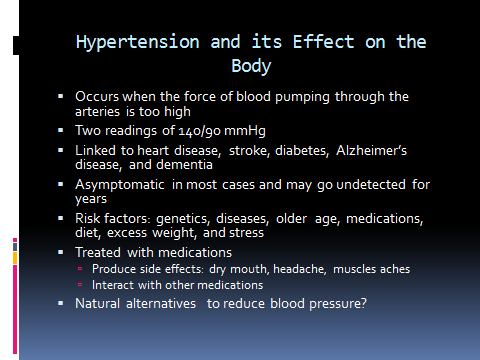
The third slide will discuss how hypertension can specifically affect senior citizens. The presenter will elaborate on specific challenges which may be faced by senior citizens, such as limited access to care, decreased mobility, and difficulty coping with chronic diseases.
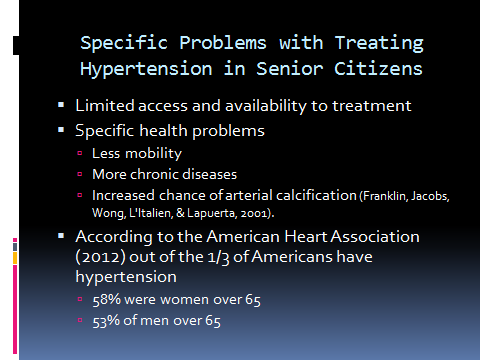
The fourth slide will discuss a healthy diet and its impact on hypertension. Participants will learn how weight, cholesterol levels, and metabolism can contribute to high blood pressure. They will then be informed of basic, healthy dietary principles which will ultimately benefit their blood pressure.

The fifth slide will discuss the benefits of the DASH diet specifically for managing blood pressure. The presenter will inform participants its effectiveness in both research and clinical trials. Participants will then learn a general overview on the DASH diet’s principles and learn how to incorporate them into their daily meals. At this time, participants will be given the handout on the meal plan based on the principles of the DASH diet.
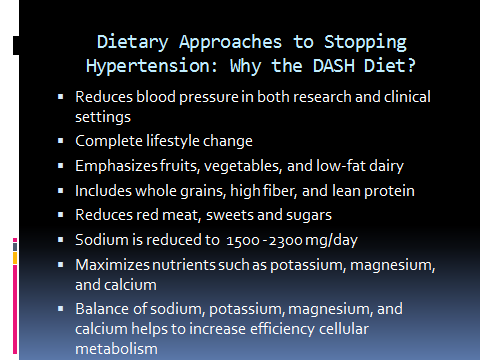
The sixth slide will discuss stress and its effects on hypertension. Participants will be informed of how stress can over-stimulate the sympathetic nervous system and will learn better methods of managing stress. Meditation will be discussed as an effective way to manage stress naturally.
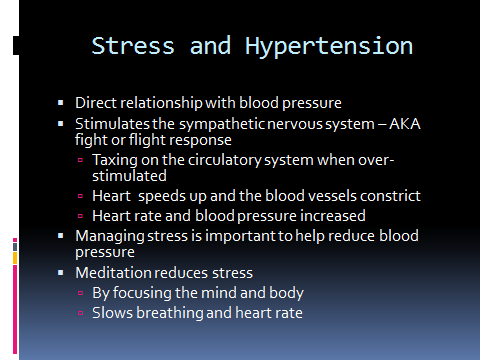
The final slide will focus on educating participants of mantra-based mediation. Participants will learn that this effective means of stress-reduction is free, convenient, and can be performed by anyone. They will then be encouraged to create a mantra that they can repeat and shown how to use that mantra in their meditation practices.
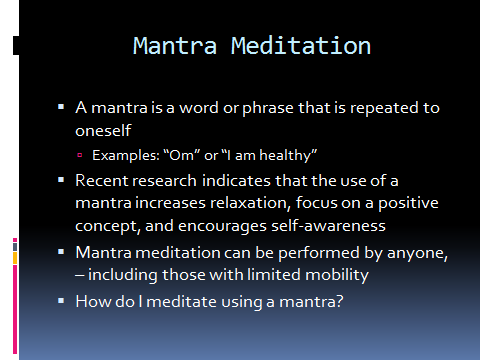
The presentation will close with a brief summation of using diet and stress reduction to help manage blood pressure. Participants will be reminded to speak with their health care providers before making any major changes to their treatment plans. The presenter will thank the pastor of Christ Community Church, the interpreters, and all who contributed to the donations for the program. The presenter will then make a special thanks to the participants for attending and show appreciation for their interest.
Afterwards, there will be time for questions and answers. Participants will be given evaluation forms to assess the effectiveness of the presentation. The donation to Christ Community Church as thanks will be offered to the pastor in private.
Evaluation Plan
Participants will be provided with a questionnaire that will assess their opinion on the workshop, the presenter, and the information they have learned. Participants will also be provided with space to write about a day with the use of the DASH diet meal plan for breakfast, lunch and dinner.
Evaluation for Presentation
| Strongly Agree | Agree | No Opinion | Disagree | Strongly Disagree | |
| The material was easy to understand. | |||||
| I learned a lot about hypertension and how it affects me. | |||||
| I learned about positive and negative dietary practices on blood pressure. | |||||
| I feel that the DASH diet is a good plan for me. | |||||
| I feel confident that I can create a meal plan based on the DASH diet principles. | |||||
| Meditation is an effective tool in managing blood pressure. | |||||
| I am confident that I can perform mantra meditation on my own. | |||||
| I am in control of my health. | |||||
| The presenter had a strong knowledge of the material. | |||||
| The presenter answered all of my questions. |
What did you like best about the presentation?
____________________________________________________________________________________________________________________________________________________________
What did you suggestions can you make for future presentations?
____________________________________________________________________________________________________________________________________________________________
Meal Plan Based on DASH Diet Principles
| Food | Amount (serving size) | Sodium (mg) | Grains | Vegetables | Fruits | Dairy | Meats, fish, poultry | Nuts, seeds, legumes | Fats and oils | Sweets and sugars |
| Breakfast |
|
|||||||||
| Lunch |
|
|||||||||
| Dinner |
|
|||||||||
| Snacks |
|
|||||||||
| Totals |
|
| Compared to 2000 calorie DASH Diet | 1500-2300 mg | 6-8 per day | 4-5 per day | 4-5 per day | 2-3 per day | 6 or less per day | 4-5 per week | 2-3 per day | 5 or less per week |
Mantra Meditation Technique
- Create a mantra. The mantra can be anything, such as “I am healthy” or “I am calm.” An example of a popular mantra is “om shanti shanti shanti,” meaning absolute peace.
- Find a comfortable seated position and breathe deeply for a few minutes.
- Synchronize the mantra with the flow of the breath, repeating it with each inhalation and exhalation. The mantra may be repeated aloud or silently.
- Continue to breathe and allow thoughts, feelings, and sensations to pass. Focus on repeating the mantra.
- Practice for at least fifteen minutes, twice a day.
This technique can be performed daily and whenever the need arises. Mantra meditation may be performed in a private or public setting.
References
Anderson, J., Liu, C., & Kryscio, R. (2008). Blood pressure response to transcendental meditation: a meta-analysis. American Journal of Hypertension, 21(3), 310-16. Retrieved from http://www.ncbi.nlm.nih.gov/pubmed/18311126?dopt=AbstractPlus
Barnes, V., Schneider, R., Alexander, C., & Staggers, F. (1997, July). Stress, stress reduction, and hypertension in African Americans: An updated review. Journal of the National Medical Association, 89(7), 464-476. Retrieved from http://www.ncbi.nlm.gov/
Beckett, N., Peters, R., Fletcher, A., Staessen, J., Lisheng, L., Dumitrascu, D., Stoyanovsky, V., & Antikainen, R. (2008). Treatment of hypertension in patients 80 years of age or older. The New England Journal of Medicine, 358, 1887-98. Retrieved from http://www.nejm.org/doi/full/10.1056/NEJMoa0801369
Burke, A. (2012). Comparing individual preferences for four meditation techniques: Zen, vipassana (mindfulness), qigong, and mantra. Explore, 8(4), 237-42. Retrieved from http://www.ncbi.nlm.nih.gov/pubmed/22742674
Cabera, M., de Andrade, S., & Mesas, A. (2012). A prospective study of risk factors for cardiovascular events among the elderly. Clinical Interventions in Aging, 7, 463-8. Retrieved from http://www.dovepress.com/a-prospective-study-of-risk-factors-for-cardiovascular-events-among-th-peer-reviewed-article-CIA
Champagne, C. M. (2006). Dietary interventions on blood pressure: The Dietary Approaches to Stop Hypertension (DASH) trials. Nutrition Reviews, 64(2), pp. 53-56. DOI: 10.1301/nr.2006.feb.S53–S56
de Rooij , S. (2012). Blunted cardiovascular and cortisol reactivity to acute psychological stress: A summary of results from the dutch famine birth cohort study. International Journal of Psychophysiology, Retrieved from http://www.ncbi.nlm.nih.gov/pubmed/23046585
Franklin, S., Jacobs, M., Wong, N., L’Italien, G., Lapuerta, P., & , (2001). Predominance of isolated systolic hypertension among middle-aged and elderly us hypertensives: Analysis based on national health and nutrition examination survey (nhanes) iii. Hypertension, 37, 869-64.
Ginty, A., Philips, A., Rosenboom, T., Carroll, D., & DeRooj, S. (2012). Cardiovascular and cortisol reactions to acute psychological stress and cognitive ability in the Dutch Famine Birth Cohort Study. Psychophysiology, 49(3), 391-400. Retrieved from http://www.ncbi.nlm.nih.gov/pubmed/22091868
Goldstein, C., Josephson, R., Xie, S., & Hughes, J. (2012). Current perspectives on the use of meditation to reduce blood pressure. International Journal of Hypertension, 2012, Retrieved from http://www.hindawi.com/journals/ijht/2012/578397/
Harnden, K. E., Frayn, K. N., & Hodson, L. (2009). Dietary Approaches to Stop Hypertension (DASH) diet: applicability and acceptability to a UK population. Journal of Human Nutrition and Dietetics, 23, pp. 3-10. doi:10.1111/j.1365-277X.2009.01007.x
Kostis JB, Cabrera J, Cheng JQ, Cosgrove NM, Deng Y, Pressel SL, et al. Association between
chlorthalidone treatment of systolic hypertension and long-term survival. JAMA. Dec 21 2011;306(23):2588-93, Retrieved from http://reference.medscape.com/medline/abstract/22187278
Lane, J., Seskevich, J., & Pieper, C. (2007). Brief meditation training can improve perceived stress and negative mood. Alternative Therapies in Health and Medicine, 13(1), 38-44. Retrieved from http://www.ncbi.nlm.nih.gov/pubmed/17283740
Rankins, J., Sampson, W., Brown, B., & Jenkins-Salley, T. (2005). Dietary Approaches to Stop Hypertension (DASH) intervention reduces blood pressure among hypertensive African American patients in a neighborhood health care center. Journal of Nutritional Education Behavior, 37, pp. 259-264.
Roger, V., Lloyd-Jones, D., Benjamin, E., Berry, J., Borden, W., Bravata, D., Dai, S., & Turner, M. (2012). Heart disease and stroke statistics – a 2012 update – a report from the American Heart Association. Circulation, Retrieved from http://circ.ahajournals.org/content/125/1/e2.full
Schneider, R. H., et al. (2001). Behavioral treatment of hypertensive heart disease in African Americans: Rationale and design of a randomized controlled trial. Behavioral Medicine, 27, pp. 83-95. Retrieved from http://www.search.ebscohost.com/
Svetkey, L. P., et al. (2005). Effect of lifestyle modifications on blood pressure by race, sex, hypertension status, and age. Journal of Human Hypertension, 19, pp. 21-31.
Trovato, G., Pace, P., Martines, G., Trovato, F., Pirri, C., & Catalano, D. (2012). Stress, abdominal obesity and intrarenal resistive index in essential hypertension. La Clinica Terapeutica, 163(4), Retrieved from http://www.ncbi.nlm.nih.gov/pubmed/23007813
Waldstein, S., Siegel, E., Lefkowitz, D., Maier, K., Pelletier Brown, J., Obuchowski, A., & Katzel, L. (2004). Stress-induced blood pressure reactivity and silent cerebrovascular disease. Stroke, 1294-98. Retrieved from http://stroke.ahajournals.org/content/35/6/1294.long
U.S. Department of Health and Human Services, (2006). Your guide to lowering your blood pressure with dash (06-4082). Retrieved from NIH Publication website: http://www.nhlbi.nih.gov/health/public/heart/hbp/dash/new_dash.pdf
Waldstein, S., Wendell , C., Leftowitz, D., Siegel, E., Rosenberger, W., Spencer, R., Manukyan,
Z., & Katzel, L. (2012). Interactive relations of blood pressure and age to subclinical cerebrovascular disease. Journal of Hypertension, Retrieved from http://www.ncbi.nlm.nih.gov/pubmed/23107913 –
Wendell , C., Hosey , M., Leftowitz, D., Katzel, L., Siegel, E., Rosenberger, W., Waldstein, S., & , (2010). Depressive symptoms are associated with subclinical cerebrovascular disease among healthy older women, not men. American Journal of Geriatric Psychiatry, 18(10), 940-7. Retrieved from http://www.ncbi.nlm.nih.gov/pmc/articles/PMC2946505/
World Health Organization, (2012). World health statistics 2012 (WA 900.1). Retrieved from WHO Press website: http://www.who.int/healthinfo/EN_WHS2012_Full.pdf

Time is precious
don’t waste it!

Plagiarism-free
guarantee

Privacy
guarantee

Secure
checkout

Money back
guarantee






